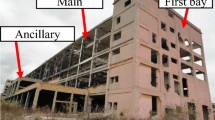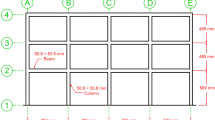Abstract
Two one-quarter-scaled, single-story, two-bay by one-bay, reinforced concrete (RC) building frame models—one each for ordinary and special moment-resisting frames (OMRF and SMRF) conforming to ACI 318 Building Code Requirements for Structural Concrete and Commentary—were tested for progressive collapse, with the objective of studying the difference in the response of the two schemes of reinforcement detailing. The load was applied at 100 mm/s on the failed middle column with 50 mm incremental vertical displacement in each loading cycle. The tests help to develop a better understanding of how connections in the floor systems perform when subjected to large deformations, as well as large catenary and membrane forces. The mechanical behavior of the models has been discussed and analyzed using a simplified model that may be used for the assessment of progressive collapse potential of RC building frames by incorporating the catenary mechanism. The collapse load for OMRF and SMRF models estimated by plastic mechanism was 62.8 and 75.5% of the tested failure capacity, respectively. The special reinforcement detailing of RC building frames (as done in SMRF) is found to help considerably in mitigation of the progressive collapse of building frames.







Similar content being viewed by others
References
Ishikawa N, Beppu M (2007) Lessons from past explosive tests on protective structures in Japan. Int J Impact Eng 34(9):1535–1545
ACI Committee 318 (2014) Building code requirements for structural concrete (ACI 318-2014) and commentary. American Concrete Institute, Farmington Hills
Department of Defense (DoD) (2013) Design of buildings to resist progressive collapse. Unified Facilities Criteria (UFC) 4-023-03, USA
Eurocode 1—EN 1991-1-7 (2006) Actions on structures—Part 1–7: general actions—Accidental actions. Eurocode
Dusenberry DO, Hamburger RO (2006) Practical means for energy-based analyses of disproportionate collapse potential. J Perform Constr Fac ASCE 20(4):336–348
Ellingwood BR, Leyendecker EV (1978) Approaches for design against progressive collapse. J Struct Div ASCE 104(3):413–423. https://www.researchgate.net/publication/285077030_APPROACHES_FOR_DESIGN_AGAINST_PROGRESSIVE_COLLAPSE
Izzuddin BA, Vlassis AG, Elghazouli AY, Nethercot DA (2008) Progressive collapse of multi-storey buildings due to sudden column loss—Part I: simplified assessment framework. Eng Struct 30(5):1308–1318
General Services Administration (GSA) (2003). Progressive collapse analysis and design guidelines for new federal office buildings and major modernization projects. Washington, DC
NBCC. National Building Code of Canada (1995) National Research Council of Canada. Ottawa, Canada
Bao X, Li B (2010) Residual strength of blast damaged reinforced concrete columns. Int J Impact Eng 37(3):295–308
Krauthammer T, Astarlioglu S, Blasko J, Soh TB, Ng PH (2008) Pressure–impulse diagrams for the behavior assessment of structural components. Int J Impact Eng 35(8):771–783
Mutalib AA, Hao H (2011) Development of P-I diagrams for FRP strengthened RC columns. Int J Impact Eng 38(5):290–304
Shi Y, Hao H, Li Z-X (2008) Numerical derivation of pressure–impulse diagrams for prediction of RC column damage to blast loads. Int J Impact Eng 35(11):1213–1227
Wu K-C, Li B, Tsai K-C (2011) Residual axial compression capacity of localized blast-damaged RC columns. Int J Impact Eng 38(1):29–40
Almusallam TH, Elsanadedy HM, Abbas H, Alsayed SH, Al-Salloum YA (2010) Progressive collapse analysis of a RC building subjected to blast loads. Int J Struct Eng Mech 36(3):301–319
Almusallam TH, Elsanadedy HM, Abbas H, Mendis P, Ngo T (2010) Numerical analysis for progressive collapse potential of a typical framed concrete building. Int J Civ Environ Eng 10(2):40–46. http://www.ijens.org/107002-8989%20IJCEE-IJENS.pdf
Al-Salloum YA, Almusallam TH, Khawaji MY, Ngo T, Elsanadedy HM, Abbas H (2015) Progressive collapse analysis of RC buildings against internal blast. Adv Struct Eng 18(12):2181–2192
Elsanadedy HM, Almusallam TH, Alharbi YR, Al-Salloum YA, Abbas H (2014) Progressive collapse potential of a typical steel building due to blast attacks. J Constr Steel Res 101:143–157
Ellingwood BR (2006) Mitigating risk from abnormal loads and progressive collapse. J Perform Constr Fac 20(4):315–323
Ellingwood BR, Smilowitz R, Dusenberry DO, Duthinh D, Lew HS, Carino NJ (2007) Best practices for reducing the potential for progressive collapse in buildings. Report no. NISTIR-7396, National Institute of Standards and Technology, Technology Administration, US Department of Commerce
Grierson DE, Xu L, Liu Y (2005) Progressive-failure analysis of buildings subjected to abnormal loading. Comput Aided Civ Infrastruct Eng 20:155–171
Kim J, Kim T (2009) Assessment of progressive collapse-resisting capacity of steel moment frames. J Constr Steel Res 65(1):169–179
Liu Y, Xu L, Grierson DE (2008) Compound-element modeling accounting for semi-rigid connections and member plasticity. Eng Struct 30(5):1292–1307
Marjanishvili S, Agnew E (2006) Comparison of various procedures for progressive collapse analysis. J Perform Constr Fac 20(4):365–374
Tsai M-H, Lin B-H (2008) Investigation of progressive collapse resistance and inelastic response for an earthquake-resistant RC building subjected to column failure. Eng Struct 30(12):3619–3628
American Society of Civil Engineers (ASCE) (2010) Minimum design loads for buildings and other structures. ASCE/SEI 7-10, American Society of Civil Engineers, Reston, Virginia
Kim J, An D (2009) Evaluation of progressive collapse potential of steel moment frames considering catenary action. Struct Des Tall Spec Build 18(4):455–465
Milner D, Gran J, Lawver D, Vaughan D, Vanadit-Ellis W, Levine H (2007) FLEX analysis and scaled testing for prediction of progressive collapse. First International Workshop on Performance, Protection & Strengthening of Structures under Extreme Loading (PROTECT 2007), Whistler, Canada
Sasani M, Kropelnicki J (2008) Progressive collapse analysis of an RC structure. Struct Des Tall Spec Build 17(4):757–771
Yi W-J, He Q-F, Xiao Y, Kunnath SK (2008) Experimental study on progressive collapse-resistant behavior of reinforced concrete frame structures. ACI Struct J 105(4):433–9. https://www.concrete.org/publications/internationalconcreteabstractsportal.aspx?m=details&i=19857
Sasani M, Bazan M, Sagiroglu S (2007) Experimental and analytical progressive collapse evaluation of actual reinforced concrete structure. ACI Struct J 104(6):731–39. https://www.concrete.org/publications/internationalconcreteabstractsportal.aspx?m=details&i=18955
Choi H, Kim J (2010) Progressive collapse-resisting capacity of reinforced concrete beam-column sub-assemblage. Mag Concr Res 63(4):297–310
Yu J, Tan K-H (2013) Experimental and numerical investigation on progressive collapse resistance of reinforced concrete beam column sub-assemblages. Eng Struct 55:90–106
Kim H, Kim J, An D (2009) Development of integrated system for progressive collapse analysis of building structures considering dynamic effects. Adv Eng Softw Arch 40(1):1–8
Vlassis AG, Izzuddin BA, Elghazouli AY, Nethercot DA (2008) Progressive collapse of multi-storey buildings due to sudden column loss—Part II: application. Eng Struct 30(5):1424–1438
Li Y, Lu X, Guan H, Ye L (2011) An improved tie force method for progressive collapse resistance design of reinforced concrete frame structures. Eng Struct 33(10):2931–2942
Sasani M, Werner A, Kazemi A (2011) Bar fracture modeling in progressive collapse analysis of reinforced concrete structures. Eng Struct 33(2):401–409
Shi Y, Li Z-X, Hao H (2010) A new method for progressive collapse analysis of RC frames under blast loading. Eng Struct 32(6):1691–1703
Kim J, Yu J (2012) Analysis of reinforced concrete frames subjected to column loss. Mag Concr Res 64(1):21–33
Wilby GK (1974) Response of reinforced concrete structures to seismic motions. Ph.D. Thesis, University of Cantebury, New Zealand
Kim JH, Mander JB (1999) Truss modeling of reinforced concrete shear-flexure behavior. Technical Report MCEER, 99-0005: New York: Multidisciplinary center for earthquake engineering research, State University of New York at Buffalo
Kupfer H (1964) Erweiterung der morsch’-schen fachwerkanalogie mit hilfe des prinzips vom minimum der formanderungsarbeit (Expansion of marsch’s truss analogy by application of the principle of minimum strain energy). CEB-Bulletin 40
Wang T, Dai JG (2014) Deformation prediction of shear critical RC beams based on a multi-angle truss model. In: Smith ST (ed), 23rd Australasian Conference on the Mechanics of Structures and Materials (ACMSM23), Vol I, Byron Bay, NSW, 9–12 Dec, Southern Cross University, Lismore, NSW, pp 313–318
Acknowledgements
The authors express their appreciation to the International Twinning Program under Vice-Rectorate for Graduate Studies and Research of King Saud University, Riyadh, for the financial grant for this project.
Funding
This study was funded by International Twinning Program under Vice-Rectorate for Graduate Studies and Research of King Saud University, Riyadh.
Author information
Authors and Affiliations
Corresponding author
Ethics declarations
Conflict of interest
The authors declare that they have no conflict of interest.
Rights and permissions
About this article
Cite this article
Almusallam, T., Al-Salloum, Y., Ngo, T. et al. Experimental investigation of progressive collapse potential of ordinary and special moment-resisting reinforced concrete frames. Mater Struct 50, 137 (2017). https://doi.org/10.1617/s11527-017-1014-x
Received:
Accepted:
Published:
DOI: https://doi.org/10.1617/s11527-017-1014-x




